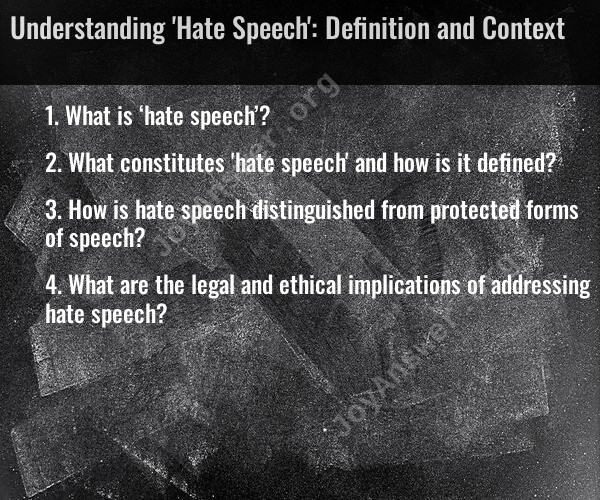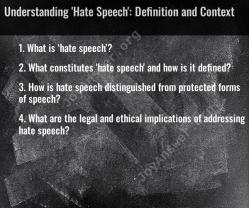What is ‘hate speech’?
'Hate speech' refers to speech, conduct, writing, or expression that offends, threatens, or insults individuals or groups based on attributes such as race, religion, ethnic origin, sexual orientation, disability, or gender. Hate speech can encompass various forms of communication, including verbal, written, or symbolic expressions, and it is typically motivated by prejudice, bias, or hostility toward a particular group or individual.
Hate speech often involves the following elements:
Targeted Groups: Hate speech is directed at specific groups or individuals based on their perceived characteristics, which can include race, ethnicity, religion, nationality, gender, sexual orientation, or other protected attributes.
Intent to Harm or Incite Harm: Hate speech is usually intended to harm or demean the targeted group or individual. It may also aim to incite or justify violence, discrimination, or prejudice against them.
Offensive Language or Symbols: Hate speech frequently employs offensive language, slurs, derogatory terms, stereotypes, or symbols that demean or dehumanize the targeted group.
Promotion of Discrimination: Hate speech often promotes or condones discrimination, intolerance, and prejudice. It can contribute to a hostile environment that endangers the rights, dignity, and safety of those targeted.
It's important to note that there is a distinction between hate speech and free speech. While many countries protect the right to free speech as a fundamental human right, they also recognize that certain forms of expression, such as hate speech, can harm individuals and society as a whole. Consequently, laws and regulations regarding hate speech vary significantly from one country to another.
Many nations have enacted laws that define and prohibit hate speech, particularly when it involves incitement to violence, discrimination, or public disorder. These laws aim to strike a balance between protecting free speech and safeguarding the rights and safety of individuals and groups. Enforcement and interpretation of hate speech laws can differ widely, and legal systems may provide mechanisms for addressing hate speech, such as civil or criminal penalties, as well as measures to counteract its effects.
The concept of hate speech is complex and can generate debates about the boundaries between freedom of expression and the need to protect vulnerable individuals or groups from harm. Public and legal perspectives on what constitutes hate speech may evolve over time, reflecting changes in social norms, values, and legal frameworks.
What constitutes 'hate speech' and how is it defined?
Hate speech is a term used to describe speech that attacks a person or group on the basis of attributes such as race, religion, ethnic origin, national origin, sex, disability, sexual orientation, or gender identity. Hate speech can be expressed through words, actions, or symbols, and it can be intended to incite violence or hatred.
There is no single, universally accepted definition of hate speech. Different countries and organizations have different definitions, and the definition of hate speech may evolve over time. However, some common elements of hate speech include:
- It is directed at a person or group on the basis of their identity.
- It is intended to dehumanize, degrade, or intimidate the target group.
- It incites violence or hatred against the target group.
How is hate speech distinguished from protected forms of speech?
In many countries, freedom of speech is a protected right. This means that the government cannot restrict speech simply because it is offensive or disagreeable. However, hate speech is not always protected by freedom of speech laws.
The distinction between hate speech and protected forms of speech is often a complex one. Courts and legislatures have developed a variety of tests to determine whether speech is protected or not. One common test is the Brandenburg test, which was developed by the Supreme Court of the United States in the 1969 case Brandenburg v. Ohio. Under the Brandenburg test, speech is only unprotected if it is intended to incite imminent lawless action and is likely to produce such action.
Another common test for determining whether speech is protected is the hate speech test, which was developed by the European Court of Human Rights. Under the hate speech test, speech is only unprotected if it is directed at a person or group on the basis of their identity and is intended to dehumanize, degrade, or intimidate the target group.
What are the legal and ethical implications of addressing hate speech?
Addressing hate speech is a complex issue with a variety of legal and ethical implications. On the one hand, it is important to protect freedom of speech. On the other hand, it is also important to protect people from the harmful effects of hate speech.
There are a number of different ways to address hate speech. One approach is to regulate hate speech through law. However, this approach can be controversial, as it raises concerns about censorship and the infringement on freedom of speech.
Another approach to addressing hate speech is through education and awareness-raising. This approach aims to teach people about the harmful effects of hate speech and to promote tolerance and respect for diversity.
A third approach to addressing hate speech is through counter-speech. This approach involves responding to hate speech with positive and inclusive messages. Counter-speech can be effective in challenging the negative stereotypes and prejudices that underlie hate speech.
The best approach to addressing hate speech will vary depending on the specific context. It is important to weigh the legal and ethical implications of any approach before taking action.
Here are some examples of different approaches to addressing hate speech:
- Legal regulation: Germany, for example, has laws that prohibit the expression of certain types of hate speech, such as Holocaust denial and incitement to racial hatred.
- Education and awareness-raising: The United States Holocaust Memorial Museum offers educational programs on the dangers of hate speech and the importance of tolerance.
- Counter-speech: The Southern Poverty Law Center monitors and exposes hate groups in the United States.
These are just a few examples of the different approaches that can be taken to address hate speech. It is important to choose an approach that is appropriate for the specific context and that is consistent with the values of the community.


